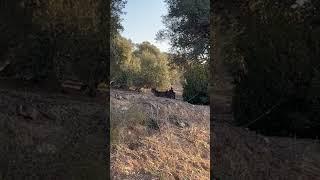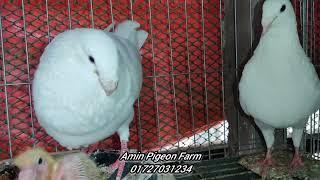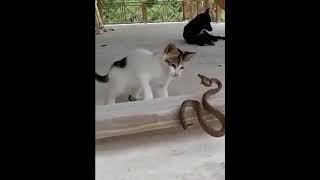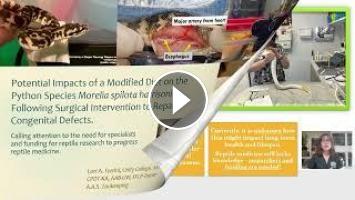Snakes in the family Pythonidae generally consume large prey items infrequently (Lillywhite, 2014). Digestion is metabolically taxing, increases heartrate and respiration, and time in between meals allows the snake’s body to rest and recover before the next feeding (Wang. 2020). Pythons can live 20-30 years or more. In cases where pythons must consume frequent, smaller meals due to medical conditions or other reasons it is currently unknown how this might impact long-term health and lifespan. The subject of this study is a West Papuan Carpet Python (Morelia spilota harrisoni) hatched with a structural abnormality involving the digestive tract and cardiac system. The Great Vessel from the heart developed around the esophagus and was compressing it, causing an inability for the animal to swallow. Veterinarian Dr. Liza Pfaff who performed the surgeries stated this condition was similar to a vascular ring anomaly in mammals. Vascular ring anomalies are rare congenital cardiovascular deviations which encircles and compresses the trachea or esophagus, or both (Yoshimura, et. al., 2020). Following two surgeries, the subject is successfully eating small food items every few days; however, is unable to swallow large food items that would be the normal appropriate size for this species. In order to maintain body weight and nutrition, small prey must be fed frequently causing the animal’s metabolism to remain in an elevated state, including an elevated heartrate for prolonged periods due to the lack of rest in between meals. This case shows a need for research into how modifying the normal feeding regimen and diet may impact pythons over their lifetime. The initial surgery was on September 10, 2021, and the subsequent surgery on October 8, 2021. She is currently eating one 4 to 7-gram fuzzy mice every 4-5 days except during ecdysis. Attempts to increase the meal size resulted in regurgitation.
References
Lillywhite, H. B. (2014). How snakes work: structure, function and behavior of the world's snakes. Oxford University Press.
Divers, S. J., & Stahl, S. J. (Eds.). (2018). Mader's Reptile and Amphibian Medicine and Surgery. Elsevier Health Sciences.
Yoshimura, N., Fukahara, K., Yamashita, A., Yamashita, S., Homma, T., Yokoyama, S., ... & Ikeno, Y. (2020). Congenital vascular ring. Surgery today, 50(10), 1151-1158.
Wang, T., & Rindom, E. (2021). The physiological response to digestion in snakes: a feast for the integrative physiologist. Comparative Biochemistry and Physiology Part A: Molecular & Integrative Physiology, 254, 110891.
Nørgaard, S., Joyce, W., Jensen, M. F., Enok, S., Skovgaard, N., & Wang, T. (2021). Histamine exerts both direct H2-mediated and indirect catecholaminergic effects on heart rate in pythons. Journal of Comparative Physiology B, 191(2), 347-355.
da Silva Vasconcelos, E., Kalinin, A. L., Cipriano, R. C., dos Santos Beserra, S., Lopes, A. G., da Costa Leite, C. A., & Monteiro, D. A. (2020). Effects of feeding and digestion on myocardial contractility and expression of calcium-handling proteins in Burmese pythons (Python molurus). Comparative Biochemistry and Physiology Part B: Biochemistry and Molecular Biology, 240, 110371.
Hansen, K., Hansen, E. S. S., Jespersen, N. R. V., Bøtker, H. E., Pedersen, M., Wang, T., & Laustsen, C. (2022). Hyperpolarized 13C MRI Reveals Large Changes in Pyruvate Metabolism During Digestion in Snakes. Magnetic Resonance in Medicine.
Filogonio, R., Wang, T., & Danielsen, C. C. (2018). Analysis of vascular mechanical properties of the yellow anaconda reveals increased elasticity and distensibility of the pulmonary artery during digestion. Journal of Experimental Biology, 221(16), jeb177766.
Card, D. C., Perry, B. W., Adams, R. H., Schield, D. R., Young, A. S., Andrew, A. L., ... & Castoe, T. A. (2018). Novel ecological and climatic conditions drive rapid adaptation in invasive Florida Burmese pythons. Molecular ecology, 27(23), 4744-4757.
Moon, B. R., Penning, D. A., Segall, M., & Herrel, A. (2019). Feeding in snakes: form, function, and evolution of the feeding system. In Feeding in vertebrates (pp. 527-574). Springer, Cham.
Stuginski, D. R., Navas, C. A., de Barros, F. C., Camacho, A., Bicudo, J. E. P. W., Grego, K. F., & De Carvalho, J. E. (2018). Phylogenetic analysis of standard metabolic rate of snakes: a new proposal for the understanding of interspecific variation in feeding behavior. Journal of Comparative Physiology B, 188(2), 315-323.
Perry, B. W., Andrew, A. L., Mostafa Kamal, A. H., Card, D. C., Schield, D. R., Pasquesi, G. I., ... & Castoe, T. A. (2019). Multi-species comparisons of snakes identify coordinated signalling networks underlying post-feeding intestinal regeneration. Proceedings of the Royal Society B, 286(1906), 20190910.
Lindsay, E. C., Metcalfe, N. B., & Llewellyn, M. S. (2020). The potential role of the gut microbiota in shaping host energetics and metabolic rate. Journal of Animal Ecology, 89(11), 2415-2426.
References
Lillywhite, H. B. (2014). How snakes work: structure, function and behavior of the world's snakes. Oxford University Press.
Divers, S. J., & Stahl, S. J. (Eds.). (2018). Mader's Reptile and Amphibian Medicine and Surgery. Elsevier Health Sciences.
Yoshimura, N., Fukahara, K., Yamashita, A., Yamashita, S., Homma, T., Yokoyama, S., ... & Ikeno, Y. (2020). Congenital vascular ring. Surgery today, 50(10), 1151-1158.
Wang, T., & Rindom, E. (2021). The physiological response to digestion in snakes: a feast for the integrative physiologist. Comparative Biochemistry and Physiology Part A: Molecular & Integrative Physiology, 254, 110891.
Nørgaard, S., Joyce, W., Jensen, M. F., Enok, S., Skovgaard, N., & Wang, T. (2021). Histamine exerts both direct H2-mediated and indirect catecholaminergic effects on heart rate in pythons. Journal of Comparative Physiology B, 191(2), 347-355.
da Silva Vasconcelos, E., Kalinin, A. L., Cipriano, R. C., dos Santos Beserra, S., Lopes, A. G., da Costa Leite, C. A., & Monteiro, D. A. (2020). Effects of feeding and digestion on myocardial contractility and expression of calcium-handling proteins in Burmese pythons (Python molurus). Comparative Biochemistry and Physiology Part B: Biochemistry and Molecular Biology, 240, 110371.
Hansen, K., Hansen, E. S. S., Jespersen, N. R. V., Bøtker, H. E., Pedersen, M., Wang, T., & Laustsen, C. (2022). Hyperpolarized 13C MRI Reveals Large Changes in Pyruvate Metabolism During Digestion in Snakes. Magnetic Resonance in Medicine.
Filogonio, R., Wang, T., & Danielsen, C. C. (2018). Analysis of vascular mechanical properties of the yellow anaconda reveals increased elasticity and distensibility of the pulmonary artery during digestion. Journal of Experimental Biology, 221(16), jeb177766.
Card, D. C., Perry, B. W., Adams, R. H., Schield, D. R., Young, A. S., Andrew, A. L., ... & Castoe, T. A. (2018). Novel ecological and climatic conditions drive rapid adaptation in invasive Florida Burmese pythons. Molecular ecology, 27(23), 4744-4757.
Moon, B. R., Penning, D. A., Segall, M., & Herrel, A. (2019). Feeding in snakes: form, function, and evolution of the feeding system. In Feeding in vertebrates (pp. 527-574). Springer, Cham.
Stuginski, D. R., Navas, C. A., de Barros, F. C., Camacho, A., Bicudo, J. E. P. W., Grego, K. F., & De Carvalho, J. E. (2018). Phylogenetic analysis of standard metabolic rate of snakes: a new proposal for the understanding of interspecific variation in feeding behavior. Journal of Comparative Physiology B, 188(2), 315-323.
Perry, B. W., Andrew, A. L., Mostafa Kamal, A. H., Card, D. C., Schield, D. R., Pasquesi, G. I., ... & Castoe, T. A. (2019). Multi-species comparisons of snakes identify coordinated signalling networks underlying post-feeding intestinal regeneration. Proceedings of the Royal Society B, 286(1906), 20190910.
Lindsay, E. C., Metcalfe, N. B., & Llewellyn, M. S. (2020). The potential role of the gut microbiota in shaping host energetics and metabolic rate. Journal of Animal Ecology, 89(11), 2415-2426.
- Catégories
- Chats de Race Burmese














Commentaires